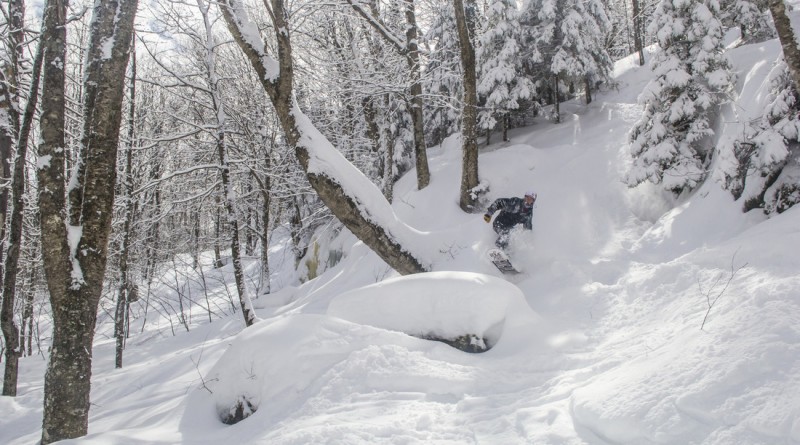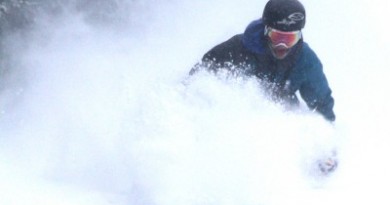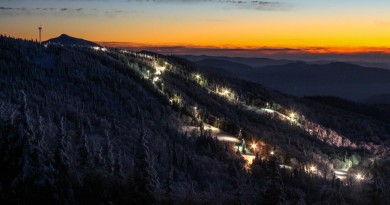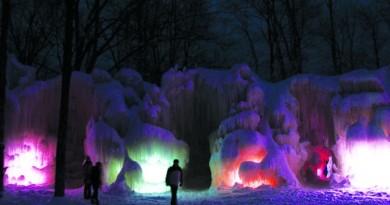Resort Policies on Backcountry Access
With backcountry skiing’s popularity on the rise, some of Vermont’s ski resorts are releasing general guidelines and policies for enthusiasts.
Few of Vermont’s 18 ski resorts have a formal, stated policy on backcountry skiing, but many do have general guidelines they follow. Here’s the response from 10 ski areas on the issue of accessing the backcountry via their ski resorts.
MAGIC MOUNTAIN
“With the former Timber Ridge ski area on the backside of Magic, there is ‘backcountry access’ here with an old trail system that still exists and is maintained by the owner of the former ski area’s property. Most find plenty of tree-skiing opportunities on the front side of our hill and see no need to go backcountry.
“But for backcountry adventurers, there is that opportunity and there are no ropes at Magic restricting access.
“There is also no transportation provided back to Magic once someone goes off to the Timber Ridge side, so skiers are solely responsible for themselves once they head off Magic’s property. We recommend skiing in groups of at least three and making sure others know when and where they are heading in the backcountry. Also bring along plenty of food, water, medical and communications equipment in case of trouble. We often have backcountry skiers ask us for routes to access the Timber Ridge side and we provide that information.”
– Geoff Hatheway, Vice President of Marketing.
BROMLEY:
“Our location on a national forest means it really isn’t our policy so much as it’s the policy of the national forest. As of now, Bromley doesn’t have that policy.”
– Michael van Eyck, Director of Marketing.
SMUGGLERS’ NOTCH:
“Skiers and boarders can access the backcountry from our area as long as they have a valid lift ticket. Once they are beyond the ski area boundary we are not bound to provide any search or rescue services. Any such services provided may be billed per Vermont State Law.”
– Karen Boushie, Public Relations Director.
BOLTON VALLEY:
“At Bolton Valley we actually have backcountry skiing as part of our 100km of Nordic and backcountry terrain; 15km of this terrain is groomed for traditional skate and classic skiing, the other 85km is backcountry. You need to have a valid trail ticket or season pass to access the terrain. Maps are available at the Nordic Center. Best of all this terrain is located next to the lift-served terrain. You can even access part of it from Wilderness Lift. As far as people accessing other backcountry areas that are not on this map, we discourage it.”
– Josh Arneson, Director of Sales and Marketing
KILLINGTON:
“Killington Resort clearly marks boundaries with flags, ropes and signage, and skiing out of bounds is not allowed. For skiers and snowboarders in search of fresh snow between the trees, Killington offers 475 acres of Natural Woods terrain in-bounds, which is open for exploration by resort guests. While it is not illegal to ski out of the ski area boundary in Vermont, like it is in some western states, Vermont law does state that skiers/riders are liable for all expenses of search and rescue if you ski or ride beyond the ski area boundary and a search is conducted.”
– Michael Joseph, Public Relations at Killington
MAD RIVER GLEN:
“We allow folks to earn their turns when MRG is not open (both pre and post season as well as after operating hours in-season). In regard to stuff “near our area” we don’t have any policies at all. Folks certainly access the side-country here at MRG, but we don’t patrol it. We do have signs warning folks they are leaving the ski area boundary.”
– Eric Friedman, Marketing Director
STRATTON
Mountains like Stratton are within the national forest, where no restrictions apply. There comment is simple: “A ticket is required to ride the lift and we do not require a ticket to hike uphill.”
Craig Panarisi, Vice President of Mountain Operations
JAY PEAK
“Our Patrol and Operations staff work with members of the Green Mountain Club to determine when to open the gate to Big Jay. Those who choose to make the trip out know that they are leaving the resort and are on their own. They’re strongly encouraged to ski in teams of three, have a whistle and some sort of communication device, have water, and to notify someone of their expected time of return.
As to accessing the backcountry routes, if you do it from the top of the resort, you have to have a lift ticket. We’re working on an uphill route policy now, but have to work through the safety issues of having two-way traffic on trails where the majority of people are not expecting to see someone skinning up and collisions can become a concern. Even accessing the trails before or after the lifts spin can be sketchy as cats and snow mobiles are zipping around the hill and winch cables can be set right at knee height and go unseen by someone skiing down during the times the lifts are closed.”
– JJ Toland, Director of Communications/Events/Partnerships
MOUNT SNOW
“Any time anyone rides a chairlift they need to be wearing a valid lift ticket or season pass. We do not actually have a policy for accessing terrain beyond the resort’s boundaries, but from the summit much of that area is public land managed by the National Forest Service as part of the Green Mountain National Forest. Since it is public land, citizens are welcome to use it at their own risk. If they access it using a chairlift at Mount Snow they need to be wearing a valid lift ticket or season pass; or if they access it via uphill travel using Mount Snow’s terrain they need to get an uphill travel pass and read the uphill travel policy before setting off.”
Dave Meeker, Communications Manager
SUGARBUSH
Basically, we are supportive of backcountry skiing as a winter sport. We point back-country enthusiasts to Slide Brook Wilderness area, a 2,000-acre area between our two mountains, which is out of bounds, not patrolled, and not maintained by our mountain operations crew. When backcountry skiers/riders want to access Sugarbush terrain within our boundaries, they then must follow the rules of our Winter Uphill Travel Policy below.
We have a policy for Winter Uphill Travel published on our website. We are strict about this policy because of safety. We operate snowmaking and grooming equipment at various hours of the day and night, requiring our heavy machinery to travel throughout our terrain. A potential encounter between an uphill skier/rider and one of our large pieces of equipment is a very dangerous scenario and one that we all want to avoid. This policy is in effect before and after our mountains open for the season, as our machinery is operating well before and afterwards in preparation for the winter season. Our policy is as follows:
Uphill travel is provided to ticket or pass-holders to access open areas during operating hours. Uphill travel is provided via the lift system, except under special circumstances (i.e. lift mechanical failure or weather hold, or special events) when uphill travel may be provided by vehicles or by hiking or skinning.
Hiking or skinning on designated trails is only permitted when specifically authorized by the Resort (these routes are only open when the weather and conditions permit).
Unauthorized uphill travel inside or outside of daily winter operating hours is prohibited.
As mentioned above, hiking or skinning on designated trails is allowed when authorized by the Resort. Often, early in the season, Castlerock will be open to hikers for a designated period of time before the lift opens—this is because it is an all-natural snow area, and some skiing helps to pack down the base, but too much skiing can be damaging before we have the snow depth.
We also allow skinning on several designated trails during operating hours, but those skiers must have a lift ticket, and must check in with guest services beforehand to find out which trails are permitted.
We offer several unique programs that can appeal to the backcountry skier:
Allyn’s Lodge Fireside Dining–this dinner can be accessed by a cabin cat ride up the mountain, or by skinning/snowshoeing with a guide. Dinner is served mid-mountain, and then skiers and riders of a certain ability level can have a guided ski/ride down afterwards.
Tour de Moon (Jan. 16, Feb. 17, Mar. 15) is a guided hike up to the Glen House at Mt. Ellen, followed by a casual dinner and a guided ski/ride down.
USSMA Sugarbush-Mad River Glen Randonnee Race on Feb. 2, 2014—an extreme challenge for backcountry skiers starting at Mad River Glen and ending at Sugarbush’s Lincoln Peak.




